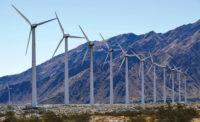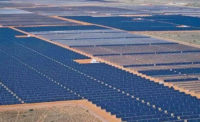As President Donald Trump and his cabinet nominees lean toward fossil fuel development to fulfill campaign promises, states are quietly pushing to keep renewable energy investment in the mix—including the first offshore wind projects in the U.S.
“States have always and will continue, even under this new administration, to lead on climate change and renewable energy,” says Liz Burdock, executive director of the Business Network for Offshore Wind.
States are out in front through renewable energy portfolio standards, with 29 now having them in place, many with components for offshore wind.
New York Gov. Andrew Cuomo (D) has committed to building 2.4 GW of offshore wind by 2030, as the state works toward supplying half of all its energy from renewable sources by that date.
On Jan. 25, the Long Island Power Authority unanimously approved what would be the state's first offshore wind project and the largest to be built in the U.S. to date.
The $740-million South Fork Wind Farm is being developed by Rhode Island-based Deepwater Wind off the coast of Long Island. The current plan is for a 90-MW wind farm in state waters, but the area is large enough to add 900 MW more. “We are confident this is the first step to developing the tremendous potential of offshore wind off Long Island’s coast,” Tom Falcone, LIPA executive director said.
According to a New York Times report, the power cost in the contract is about 16 cents/kWh, compared to the average price for all energy sources that now is 7.5 cents/kWh. A LIPA spokesman could not confirm the exact power contract price due to a confidentiality clause in the contract, but he said "it’s important to note that when combined with delivering the energy to the right location on the electric grid, the project provides an all-in wind energy price that is competitive with other clean energy sources without being as land intensive as other renewable alternatives."
The planned project would be triple the capacity of the wind farm completed last year by the company, a 30-MW facility near Block Island off the Rhode Island coast, that now is producing power for the island and sending via underwater cable to the mainland grid.
Maryland regulators could decide by May which of two offshore wind proposals it will choose to be built off the coast of Ocean City. The Maryland Public Service Commission scheduled hearings for March on a 120-MW project proposed by Deepwater Wind.
The state also is considering a much larger 750-MW project proposed by US Wind, a subsidiary of Renexia, the renewable energy arm of the Italian engineering and construction firm Toto Holdings. Renexia said only 248 MW of the project would be supported by Maryland’s 2013 offshore renewable energy credit law, which created a 2.5% carve-out for offshore wind beginning in 2017.
Renexia’s project, projected to cost $4 billion, will include $90 million in capital improvements for the Port of Baltimore, the company said. The project would begin commercial operations in 2020. The Deepwater Wind project would come online in November 2022, the company said.
Maryland’s legislature expanded the state’s renewable energy portfolio standard to 25% by 2020, from 20% by 2022. But Republican Gov. Larry Hogan vetoed the measure in May. “This legislation is a tax increase that will be levied upon every single electricity ratepayer in Maryland,” he said in his veto.
The Maryland House of Delegates overrode the veto on Jan. 31. The state senate will attempt to override the veto on Feb. 2.
“The Maryland House of Delegates voted to reject the anti-environmental agendas of both Larry Hogan and Donald Trump,” Mike Tidwell, director of the Chesapeake Climate Action Network, said. The vote is evidence that states will fight back attempts to stall progress on clean energy jobs and reduce global warming pollution, he added.
Other eastern states with high renewable energy portfolio standards include Vermont at 75% by 2032, Maine at 40% by 2017, and Rhode Island at 38.5% by 2035
New Jersey, which has a 20.38% renewable energy standard by 2020, was an early proponent of offshore wind. A bill calling for the development of 1,100 MW offshore was signed into law in 2010, and while it has stalled during the administration of Republican Gov. Chris Christie, development is expected to take off next year after he leaves office, several industry sources said.
Massachusetts has the largest commitment to offshore wind at 1,600 MW over 10 years.
West Coast states also see alternative energy potential, with California and Oregon both setting 50% standards by 2030, according to the U.S. Department of Energy.
Hawaii also is considering offshore wind projects: AW Hawaii Wind has proposed two 400-MW projects off Oahu’s coast and Progression Hawaii Offshore Wind has also proposed a 400 MW project, located there.
Hawaii has set a goal is to reach 100% renewable energy by 2045.
“Progressive governors and state legislatures in blue coastal states will continue to lead the development of offshore wind,” Burdock of the Business Network for Offshore Wind said.
The federal Bureau of Ocean Energy Management said Jan. 17 it would offer a commercial wind lease sale off the coast of North Carolina on March 16, the seventh done by the agency. The Federal Register notice was published before Trump took office and expected to move forward.
It’s unknown whether the Trump Administration will continue to support future lease sales, but Burdock predicted that additional leasing will be delayed by two years.
Future of Tax Credits
The federal government’s production and investment tax credits have been critical to driving growth in the renewable energy industry, officials say.
In 2015 Congress approved a five-year extension and phaseout of the renewable production energy tax credit. The credit is 2.3 cents/kwh for projects that are started by the end of the year. For wind, it begins to phase out in 2018 and ends in 2020. For solar, the production tax credit ends in 2024.
The Business Network for Offshore Wind is optimistic about the future of renewable energy under Trump. “President Trump promised jobs. He probably cares very little about what industries originate the jobs as long as they materialize,” Burdock said.
Renewable advocates have forecast if the production tax credit remained in place, renewables could supply 20% of the nation’s energy by 2030 and support the creation of 380,000 jobs.
Executives of Deepwater Wind and other U.S. offshore wind developers, as well those of large European developers Dong Energy and Statoil that seek U.S. projects, declined requests to be interviewed for this story, as did the American Wind Energy Association.




Post a comment to this article
Report Abusive Comment